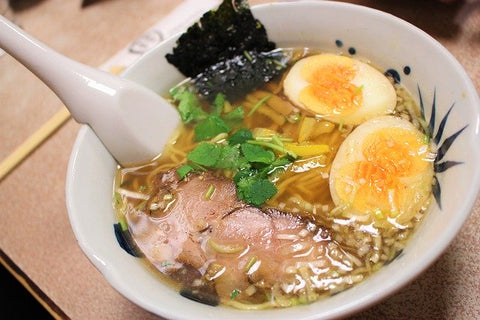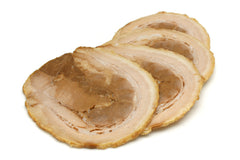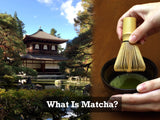
Shio ramen looks like this…

Ever wondered what “shio” is?
Shio means salt in Japanese.

So this ramen is a noodle dish with a salt-based broth.
The word before ramen usually refers to the type of soup it is.
Let’s look at other examples:
Shoyu ramen soup is made of soy sauce, miso ramen soup is made of miso,
And tonkotsu ramen soup is made of tonkotsu (pork bone).
You might think...
What does shio ramen taste like?

Shio ramen has a thin and simple taste compared to other ramen types.
That is the best part of it, and what I find myself always craving.
You will taste the flavor of chicken, clams, or different types of seafood in the broth.
Unlike miso ramen or shoyu ramen,
You can feel the umami of the soup directly.
It is perfect for lunch, a late night snack,
Or finishing off a drinking party with this shio ramen.

Common toppings for shio ramen are…
Chashu, menma, ajitama, and green onions.

1. People think shio ramen is not the first choice…
2. Unknown types of shio ramen
3. The actual history of shio ramen
4. Shio ramen recipe you will be excited about
5. Must try shio ramen instant noodles

1. People think shio ramen is not the first choice…

It makes me sad...
Have you ever had good shio ramen?
Shio ramen is generally lighter in taste and color than its shoyu and miso ramen counterparts.
Shio ramen has a transparent soup base.
It is actually very difficult to find good shio ramen.
Do you know why?
Because it is very difficult to make since it is very simple.
But remember:

Good shio ramen is REALLY GOOD!
You have to use the best and freshest ingredients for shio ramen.
Broth is the most important aspect of the shio ramen.
Because you can't cover up the taste using strong flavours like miso or soy sauce.
Thin sliced tender chashu, medium-thick noodles that are nicely covered with well balanced umami rich and sophisticated soup...
It makes me overjoyed just imagining good shio ramen!

2. Unknown types of shio ramen
Do you know there are some kinds of shio ramen?
There are some regional, ingredient, or recipe differences.
You will never get bored of eating shio ramen since there are many options and it will keep you from being bored.
Here are some shio ramen types...
i. Yuzu shio ramen
When I eat yuzu shio ramen, I feel very refreshed because of the citric taste.
It also makes me feel healthy as the broth is light and oil-free.
Yuzu is a type of Japanese citrus.

Juice or yuzu is used in the ramen soup, and you can also see yuzu peels on top of ramen as a topping.
Yuzu shio ramen is known as the famous ramen restaurant Afuri’s signature ramen.
They make a beautiful and mouth-watering ramen.
Soup: Transparent salt-based soup made by chicken-based broth, seafood, and some vegetables.
Noodles: Thin straight, low water addition rate
Toppings: Chashu, ajitama (ramen egg), menma (bamboo shoots), mizuna (Japanese mustard greens), nori (roasted seaweed), and yuzu
ii. Hakodate Ramen (Hakodate, Hokkaido)

Hakodate is the place of shio ramen!
People there are proud of their regional ramen.
This classic-looking Hakodate ramen has a nice and easy taste, you will feel hearty after eating it.

Soup: Transparent salt-based soup, pork bone or chicken bone broth, konbu, scallops, and some vegetables
Noodles: Medium thin straight (cutter number: 22 to 24), high water addition rate: 40%
Toppings: Chashu, menma, and green onions
iii. Churashio Ramen

In Okinawa, soki soba is the local soul food there, but ramen has been getting popular.
You will be really curious and want to eat this churashio ramen after knowing how unique it is.

Characteristics of churashio ramen are…
Soup: Salt-based soup made by combining seafood and pork bone broth and Okinawan salt
Noodles: Medium-thick straight
Toppings: Konbu, soki (stewed pork spare ribs), and eggs marinated with turmeric
iv. Tanmen

Tanmen was born in Yokohama.
Tan-men is mainly eaten in the Kanto region (the capital of Japan, Tokyo, is a part of this region).
Because I was born there, I feel nostalgic and homesick of my mom’s cooking when I eat tanmen.

Tan-men consists of a combination of pan-fried vegetables, like bean sprouts, leeks, carrots, cabbages, onions, mushrooms and pork.
The chef then pours these toppings onto a bed of ramen and adds in a soupy mixture of chicken-bone broth and salt tare.
With a light chicken-bone broth, salt tare, and a wide range of colourful and fresh vegetables,
The lesser-known tanmen is highly nutritional as opposed to its popular miso, shoyu, shio-based ramen counterparts.

Soup: Light chicken-broth and salt tare
Noodles: Medium thick
Toppings: Bean sprouts, leeks, carrots, cabbages, onions, mushrooms and pork
Actually, tanmen is not considered “ramen” by some,
Despite the fact that it tastes like shio ramen because of its different cooking process.

Let’s take a look at the cooking process...
Ramen:
1. Pour broth and sauce into a bowl.2. Put boiled noodles into the same bowl.
3. Put toppings on top.
Done!
Tanmen:
1. Pan fry meat and vegetables.2. Pour water into the same pan and boil fried meat and vegetables to make soup.
3. Put noodles into a bowl.
4. Pour soup into the same bowl
5. Put vegetables on top.
Done!


3. The actual history of shio ramen
Out of the 4 most popular ramen types, shio, tonkotsu, miso, and shoyu ramen, which one do you think was “invented” first?
A. Shio ramenB. Tonkotsu ramen
C. Miso ramen
D. Shoyu ramen
You're correct if you guessed…

“A” - Shio Ramen

In 1884, a ramen restaurant called “Youwaken” in Hakodate published an advertisement in the newspaper.
This is the oldest record that ramen was ever served at a restaurant.
Since Hakodate was a port city, there were many foreigners including Chinese merchants who came to Japan to look for konbu (kelp) and other seafood.
Youwaken’s main customer base were these Chinese merchants.
For that reason the root of Hakodate ramen is salt-based soup noodles which were created to cater to these Chinese merchants’ taste preference.

4. Shio ramen recipe you will be excited about
Curious as to how you can create your own shio ramen from scratch?

You will be proud of and 10x enjoy your shio ramen better if you make it from scratch.
Take a look here!

Component #1: Salt Tare (Salt Sauce)
Ingredients:Sake 4TBSPs
Water 4TBSPs
Salt 1tsp
Soy sauce 1tsp
Bonito 5 grams
Directions:1. Pour water, sake, salt, and soy sauce.
2. Put bonito in it when 1 boils.
3. Turn off the heat and wait until bonito goes on the bottom of the pot.
4. Get rid of bonito by filtering and straining it.
Done!

Component #2: Broth
Learn how to make broth from scratch!

Component #3: Chashu
Learn how to make chashu from scratch!
Component #4: Ajitama
Learn how to make ajitama (ramen egg) from scratch!
Component #5: Noodles
Learn how to make noodles from scratch!
Component #6: Green Onions
Chop up green onions.
Now that you have all the components of the ramen, let’s start making shio ramen!
Directions for Shio Ramen
-
Boil noodles in a pot.
-
Prepare a ramen bowl and pour in the salt sauce and broth.
-
Mix the salt sauce and broth together.
-
Put drained noodles in the bowl.
-
Put in your ramen toppings: ajitama ramen egg, chashu, and chopped green onion.
Fancy some other toppings other than the ones listed above? Take a peek at some of our other topping suggestions!

5. Must try shio ramen instant noodles
You want to try shio ramen,
But you don’t have a ramen restaurant that serves shio ramen?
That is really tearful...
Here is some good news:
I will introduce you to my favorite shio flavoured instant noodles!
i. Sapporo ichiban shio ramen
There are many good shoyu and miso-flavored instant noodles out there.
But I feel specifically, the shio flavor market is monopolized by Sapporo Ichiban.
Think about this for a moment having good shio ramen for your dinner with your favorite ramen toppings.
I made a full review about this instant noodles.

Review: Sapporo Ichiban Shio Flavor
ii. Nissin Ramen-yasan Hakodate Shio
This is a good counterpart of the Sapporo ichiban shio flavor.
They have very different taste despite both being shio ramen.
You will feel the umami of the scallops from the soup.
And the soup is really good.

Noodles are a little soft and chewy, and the noodles make this ramen unique.
Try it with homemade ramen eggs or chashu.
Full Guide to 8 Ramen with Eggs. Which Do You Want to Try?
Poof! Authentic Tender and Juicy Chashu for This Weekend

iii. Dashimen Hokkaido Hotate Shio Ramen (Scallop stock instant noodles)
This scallop stock soup is very yummy.
It is very thick as shio ramen soup.
I recommend putting a lot of vegetables because they will go really well with this soup.
These noodles have nice chew and they are closer to raw noodles.

If ramen or any other types of Japanese style noodles and soup is comfort food for you, you might be thinking that you need ramen bowls.
Ramen bowls are perfect for a large bowl of ramen.
They are big enough to pile on the fixings, they are durable, and best of all, they look beautiful.
Share a bowl of warm, hearty home cooked ramen with your family, friends and loved ones for your ramen night.
Or when you order take out, transfer the noodles from those awful looking containers.
You and your family will be so excited and can’t wait until your next ramen night to use these bowls!
About the Author

"I am from Ibaraki, Japan.
Ramen is great! It can bring you a sense of happiness and satisfaction that no other food can. I have been eating ramen for 30 years.
If there is no ramen, my life would be miserable.
Ten years ago, I worked as an office worker. The job was really stressful - excessive working hours, low wages, unpaid overtime work, and constantly being yelled at by my boss.
I was new and alone, no girlfriend, no friends, and felt very lonely.
My only oasis was the ramen shop near the office. For me, the ramen chef there was literally an angel. I saw a halo on his head. (No joke)
Tonkotsu shoyu ramen was my all-time favorite. He made ramen with broth chock-full of umami flavor, nice chewy handmade noodles, and tender chashu.
My greatest dream is connect people with ramen through my blog. I want to share a lot of interesting and funny stories and ramen trivia with you.
Knowing more about ramen can help you appreciate your ramen and make it taste extra delicious."
All The Different Ramen Types: It'll Instantly Make You A Ramen PhD










Hi Alexei,
Thanks for the suggestion. Fried spam sounds like a great, quick and easy topping. Thanks for taking out the time to leave us a comment!
Thank you for writing this up, I happened to find sapporo shio ramen at a meijers in a remote area of Michigans upper peninsula a few months ago, never bothered to look up about it but happened upon this page. Went out and grabbed the toppings I could and made it. Also tastes good if you thin slice some spam and pan fry it before using as a topping if you live remote and can’t find all the good ingredients. Love the review, must plan a trip to japan.
Hi Steve,
Thanks for leaving us a comment and spotting the typo.
The amount of sake and water should be 4 tablespoons (each), and not teaspoons.
Sorry for the confusion – I’ve updated the recipe!
Thanks for the great websites.
But on the shio tare how exactly am I supposed to boil 4 teaspoons of water and four teaspoons of sake it’s not enough even to soak the bonito and dilute the salt.
Leave a comment